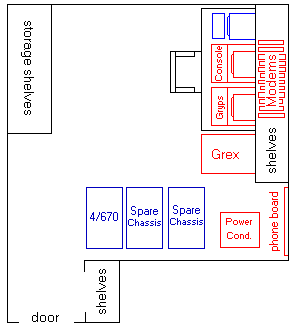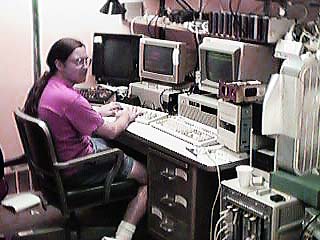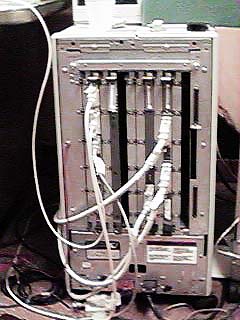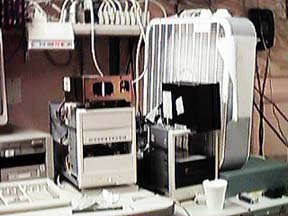 Grex's computers are housed in small windowless room in an
old industrial building in Ann Arbor, Michigan.
We rent this space for $60 a month (not including electricity).
We refer to this room as "The Pumpkin."
This web page gives a short tour of it.
Grex's computers are housed in small windowless room in an
old industrial building in Ann Arbor, Michigan.
We rent this space for $60 a month (not including electricity).
We refer to this room as "The Pumpkin."
This web page gives a short tour of it.
We have been housed in our current location since late in 1996. The photo tour of our previous location ("The Dungeon") is still available. It shows mostly the same computers and furniture in a different room.
Because the room is rather small, it is hard to take pictures in.
Without a wide angle lens, you can't get far enough from anything to fit
very much in one shot.
The map at left will help you fit the views together.
The red stuff is the working Grex computer system.
The blue stuff is various spares and stuff.
The black stuff is walls and furniture.
The room is not as neat as the map.
 Our first image shows Steve Gibbard, one of Grex's staff members, seated
at Grex's console. I believe he was actually in the process of rebooting
Grex when these pictures were taken, so Grex isn't actually functioning in
any of them, but it looks much the same either way.
Our first image shows Steve Gibbard, one of Grex's staff members, seated
at Grex's console. I believe he was actually in the process of rebooting
Grex when these pictures were taken, so Grex isn't actually functioning in
any of them, but it looks much the same either way.
On the desk in front of Steve there are three monitors. The left-most one is an old Ann Arbor Ambassador terminal which was Grex's console for many years, but is broken and no longer being used.
The center computer with the amber screen is Grex's console. It is an original IBM PC with a 20 megabyte "hardcard" for a disk drive, and a note stuck to the monitor advising people to be patient when rebooting it because it is really, really slow. The only thing we run on it is the Kermit terminal emulator. So for our purposes, it is just a terminal with scrollback.
The computer on the right, with the green monitor, is a 386 running freeBSD Unix. This machine is called "gryps" and serves as our router. It routes packets that come in over our internet connection onto our local Ethernet, so all internet traffic to or from Grex passes through this machine. If the net connection fails, it automatically re-establishes the connection. The small white box dangling off the shelf above it is gryps' modem, through which it establishes a ppp connection to our ISP, IC-Net. It has a Ethernet card that lets it pass packets on to Grex.
We are about to upgrade our internet link from a 28.8K baud dial-up ppp connection to an ISDN connection. When that happens, Gryps and the link modem will be retired and replaced by a tiny little Ascend Pipeline P50 box.
On the shelf above the console and gryps is a row of modems balanced precariously on their sides, which serve our local dial-in users. They are GVC 14.4 error correcting modems, but they are programmed to connect only at 2400 or 9600 baud, because Grex's serial interfaces can't handle faster rates. There are more shelves above the one in the picture, containing mostly junk.
Grex itself is on the far right of the picture - it's the large box on the
floor next to the desk with lots of cables hanging out.
Let's look at a better picture of that.
 OK, here's a picture of Grex. What you see is actually the back of the
chassis, with the power supply on the bottom and twelve card slots on top.
We keep the front facing the wall because all the interesting stuff is in back.
This is a chassis made by Computer Vision, a company that sells Sun-compatible
hardware.
Only four of the twelve VME card slots are being used in this picture.
OK, here's a picture of Grex. What you see is actually the back of the
chassis, with the power supply on the bottom and twelve card slots on top.
We keep the front facing the wall because all the interesting stuff is in back.
This is a chassis made by Computer Vision, a company that sells Sun-compatible
hardware.
Only four of the twelve VME card slots are being used in this picture.
 This picture shows Grex's disk drives, standing on the end of the desk next
to gryps and on top of the Grex chassis.
Each enclosure has room for two full-height SCSI disk drives.
Theoretically, of course, the disk drives should be inside the
external enclosures instead of being balanced precariously on top.
But a while back some of the fans in the disk enclosures died, so Marcus
put the disks on top and rigged up the big box fan next to them to keep them
cool until someone got new disk enclosures.
Because he regarded this situation as precarious and temporary, he put a
sign on the fan saying "touch and die!"
It's been like that, sign and all, for about a year now.
This picture shows Grex's disk drives, standing on the end of the desk next
to gryps and on top of the Grex chassis.
Each enclosure has room for two full-height SCSI disk drives.
Theoretically, of course, the disk drives should be inside the
external enclosures instead of being balanced precariously on top.
But a while back some of the fans in the disk enclosures died, so Marcus
put the disks on top and rigged up the big box fan next to them to keep them
cool until someone got new disk enclosures.
Because he regarded this situation as precarious and temporary, he put a
sign on the fan saying "touch and die!"
It's been like that, sign and all, for about a year now.
The left-hand enclosure contains the drive with Grex's root partition inside, and, balanced on top of it, is the 2 gigabyte drive on which all user home directories are stored. The right-hand enclosure contains a (rarely used) back-up tape drive on the bottom, and, balanced on top of that, a 300 megabyte CDC Wren drive that serves as Grex's swap disk.
On the shelf above the disk drives, just to the right of the link modem,
is the break-out box for the ALM card. All those cables plugged into it
go to the dial-in modems.
Behind the fan you can get a glimpse of the phone board.
Let's take a closer look at that.
 Here's a shot of the phone board.
This is a chunk of plywood that we nailed to the wall above a little trap
door that leads to a crawlspace under a stairwell adjoining our office.
Coming in a hole in the lower right-hand corner is the end of the 50 conductor
cable that we strung down into the building's basement phone closet.
It ties in to the yellow punch-down block on the right side, which connects
to an assortment of phone jacks, which the modems connect to.
We even have a voice phone hanging from the wall there, so we can yell
for help.
Boring, huh?
Here's a shot of the phone board.
This is a chunk of plywood that we nailed to the wall above a little trap
door that leads to a crawlspace under a stairwell adjoining our office.
Coming in a hole in the lower right-hand corner is the end of the 50 conductor
cable that we strung down into the building's basement phone closet.
It ties in to the yellow punch-down block on the right side, which connects
to an assortment of phone jacks, which the modems connect to.
We even have a voice phone hanging from the wall there, so we can yell
for help.
Boring, huh?
 There are actually a number of other things that resemble computers scattered
around the pumpkin.
This shot shows the whole row of them, standing just below the phone board.
The one on the left is Grex, which we have previously visited.
There are actually a number of other things that resemble computers scattered
around the pumpkin.
This shot shows the whole row of them, standing just below the phone board.
The one on the left is Grex, which we have previously visited.
Next to it is an identical Computer Vision chassis currently being used as a storage bin for extra VME cards. When Grex was running on a Sun 3 CPU, it was running out of this chassis. We keep it as a spare. We also have spares for all the cards in Grex.
In the middle of the picture, peeking out between two computer chassis, is our power conditioner. The Grex computer and the disk drives are plugged into this.
The third chassis with the two fans on top is an actual Sun 3 chassis, donated to Grex by Tod Plesco. In theory, another chassis might do a better job of supporting all our memory cards, but the testing we've done seems to indicate that this is even flakier than the ancient Computer Vision chassis we are now using, so it's acting as a storage bin too.
Finally, the right-most chassis is the computer that will replace Grex when we finally get it working, a Sun 4/670.
The various paper cups standing on tops of computers are full of little
spare parts.
They serve as booby traps to shower unwary staffers with showers of screws
and washers.
 This rather bare looking box is, we hope, the future of Grex.
We bought a Sun 4/370 that the University of Michigan was about to push off
into a dumpster, removed the 4/300 CPU card,
and replaced it with a 4/600 CPU with two processors on a piggy-back board
to make a 4/670 (4/370 minus 4/300 plus 4/600 equals 4/670).
When it's ready to run, it should be about five times faster than the current
4/260.
This rather bare looking box is, we hope, the future of Grex.
We bought a Sun 4/370 that the University of Michigan was about to push off
into a dumpster, removed the 4/300 CPU card,
and replaced it with a 4/600 CPU with two processors on a piggy-back board
to make a 4/670 (4/370 minus 4/300 plus 4/600 equals 4/670).
When it's ready to run, it should be about five times faster than the current
4/260.
There are twelve card slots in this too, but all you see is a big gaping hole because the only thing in it is the CPU card. Unlike our older machines, the memory and the SCSI controller all live on the CPU card, so most of those slots will stay empty. We will need a slot for our memory expansion card and we may need a slot for the ALM card, if we don't get the terminal servers on line before we get the 4/670 on line.
The cable looping up from the CPU card to the top of the chassis is the SCSI cable. There are three SCSI drives and a CD-ROM drive inside the top of the chassis. The terminal balanced on top of the chassis is the temporary console being used to configure the system.
Behind the 4/670 we see a cart outside our door that belongs to one of the
other companies that shares our building.
 I suppose you've been wondering why we call our room "The Pumpkin."
Well, this picture of the back wall should explain it.
The walls are pumpkin orange and there are pumpkin leaves and flowers,
plus the occasional butterfly painted on it.
Interesting, eh?
I suppose you've been wondering why we call our room "The Pumpkin."
Well, this picture of the back wall should explain it.
The walls are pumpkin orange and there are pumpkin leaves and flowers,
plus the occasional butterfly painted on it.
Interesting, eh?
The wall color was supplied by a previous tenant (possibly "Word of God"). Inspired Grex volunteers added the pumpkin leaves to complete the theme. Unfortunately, shelves and phone boards cover most of the decoration.
At the left of the picture are two floor-to-ceiling shelves full of
more bits and pieces and spare parts, including boxes and boxes full
of such treasures as Sun 3 cards, non-functional UPSs, and some of the
most dubious disk enclosures known to humanity.